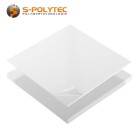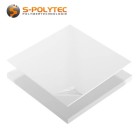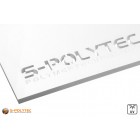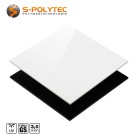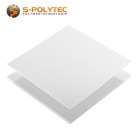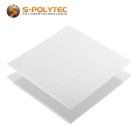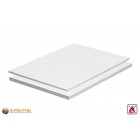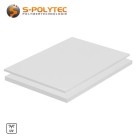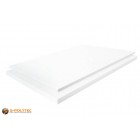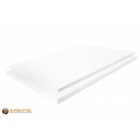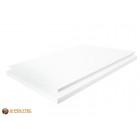
Buy white plastic sheets online at best prices
We offer you high-quality plastic panels in white in various designs in millimetre-precise cut to size or as standard panels in many thicknesses and plastic types.
- With customised plastic sheets, the white sheets are cut precisely to your specifications
- We also stock food-safe and flame-retardant plastic sheets in white
- Our white plastic sheets are available in a wide range of thicknesses and designs
- All white plastic sheets are evenly pigmented and fully coloured
ABS sheets white made to measure
 from €13.86 / m2
from €13.86 / m2Incl. 19% Tax
ABS sheets white 2x1meter
 from €17.77 / pcs
from €17.77 / pcsIncl. 19% Tax
Acrylic glass white (opaque) laser cut

Opaque GS cut to size (opaque)
 from €48.08 / m2
from €48.08 / m2Incl. 19% Tax
Polystyrene sheets white custom cut
 from €10.42 / m2
from €10.42 / m2Incl. 19% Tax
Polystyrene sheets white 2x1meter
 from €16.02 / pcs
from €16.02 / pcsIncl. 19% Tax
Aluminium composite panels white 3mm
 from €27.97 / m2
from €27.97 / m2Incl. 19% Tax
Hard-PVC sheets white 2x1 meter
 from €15.43 / pcs
from €15.43 / pcsIncl. 19% Tax
Hard-PVC sheets white 2x1meter (UV-stabilised)
 from €19.15 / pcs
from €19.15 / pcsIncl. 19% Tax
PTFE Sheets white custom cut
 from €75.58 / m2
from €75.58 / m2Incl. 19% Tax
PTFE sheets white 0.6x0.6meter
 from €136.45 / pcs
from €136.45 / pcsIncl. 19% Tax
PTFE sheets white 1.2x1.2meter
 from €541.93 / pcs
from €541.93 / pcsIncl. 19% Tax
White plastic sheets
White plastic sheets cut to size - inexpensive and fast
We at S-Polytec offer a wide range of plastic sheets in many different designs, thicknesses and colours. The properties of our plastic sheets in white are extremely diverse and vary depending on the plastic selected. From high-quality sheets with food approval, to weatherproof sheets for outdoor use, to flame-retardant plastic sheets. We have one or more plastic sheets in white in our product range for almost every application. In some areas of application, especially in industry, plastic sheets with a high chemical resistance are required. For such demanding purposes we have different white sheets in stock, which of course comply with the EU chemical regulation REACH. For applications where a high stability of the sheet is required, we offer impact resistant and rigid plastic sheets made of various materials. These are used, among other things, for partition walls and cladding and can also withstand high mechanical loads. We even have white sheets with the necessary ETB approval for special applications such as balcony edgings and balcony screens. These can be used outdoors without hesitation. It is not only very important to us to guarantee the best possible quality, but also to offer our products at fair and favourable prices.
In our machinery, we cut the panels to your desired size with millimetre precision, but can also offer and ship them in the standard format of 2000x1000mm, depending on the plastic. Even for larger orders and extensive cutting, we are able to process your order promptly and with short delivery times thanks to our extensive warehousing. In some cases, special cuts in any shape are required. For this demanding work, we have several CNC portal milling machines with which, thanks to state-of-the-art computer control, we are able to produce even complex shapes and structures with the highest precision. In addition, we have several CO2 laser cutting machines of the latest generation, which are used when a polished edge or very filigree shapes are required for the cuts.
Our standard delivery programme for plastic sheets in white
- Highly weather-resistant HPL decorative panels in traffic white or cream white in precision cut
- Bend-resistant aluminium composite panels with stove-enamelled surface in white on both sides, cut to size
- Impact-resistant ABS sheets in white in cut-to-size or as standard sheets in 2000mm x 1000mm format
- White acrylic sheets or opal (frosted glass look)in saw cut or as laser cut
- Natural polyethylene sheets in cut to size or as standard sheet in 2000mm x 1000mm format
- Polypropylene sheets (PP-H) in natural or white as standard sheets in the format 2000mm x 1000mm
- White rigid PVC sheets with and without UV stabilisation in standard format 2000mm x 1000mm
- Polystyrene sheets (PS) in white in cut to size or as standard sheet in the format 2000mm x 1000mm
- White PTFE sheets in the formats 600 x 600mm, 1200 x 1200mm, 2000 x 1000mm and cut to size
Our extended delivery programme on request
- HPL sheets in various shades of white or larger formats up to a size of 3050mm x 1300mm
- Aluminium composite panels as standard panels or large blanks up to a format of 3050mm x 1500mm
- Individual milled parts from our plastic panels in white according to your design drawing
- Matching mounting material with head lacquering in white, for example for HPL or aluminium composite panels
- and much more
NOTE: Please note that the delivery times and shipping costs for our extended delivery programme may vary. If you have any questions about our white plastic sheets, our qualified consulting staff will be happy to inform you at any time.
Typical examples of white plastic sheets
Our plastic sheets are extremely versatile. Depending on the thickness and plastic, our sheets in white have a rather low to no light transmission, so they are often used for privacy screens and cladding. An exception are the opal acrylic sheets, which are considered opaque but still have very good light transmission. Such sheets are very popular for the production of lighting elements, illuminated advertising displays or also as room dividers with a high light transmission. Due to their neutral colour, white sheets, depending on the material, are ideal for direct printing, but also for varnishing and foiling. Accordingly, plastic sheets in white are preferred for the production of advertising signs and art prints. The majority of our sheets are thermoplastics and therefore suitable for thermal forming. This means that they can be formed into almost any shape, which is retained after the moulded part has cooled. In some areas of application, colour plays a rather subordinate role and thus sheets made of polyethylene or propylene are used in a wide variety of areas due to their many positive properties. The same applies to PTFE, which is white by nature and only rarely available in other colours (black PTFE, for example).
- In sign making, white aluminium composite and PVC sheets are preferred for printed signs and billboards
- In interior design, scratch-resistant acrylic sheets can be used for decorative wall and ceiling cladding
- For outdoor use, acrylic glass and HPL sheets are suitable for balcony balustrades, privacy and rain protection
- In industrial processing, ABS, PS or PP sheets are thermoformed into finished plastic parts
- In furniture construction, HPL, acrylic glass or ABS sheets are ideally suited for shelves, partitions and panelling of furniture pieces
- In the food industry, food-safe polypropylene, polyethylene and PTFE sheets in white are very commonly used
White is not just white
There are a number of factors that define a colour shade, so white is not always white. Depending on the manufacturer or the colour system used, there are many different shades of white available on the market. From bright white, which has a comparatively high blue content, to almost beige cream white. Even if the name of the shade of white is identical in the different colour systems, the white can differ. This means that a white from the colour palette of the Pantone colour system is not comparable with a white of the same name from the HKS colour system or the RAL colour table. Within a colour system, for example the very widespread RAL colour system, colour tones are exactly defined regardless of whether wall paints and lacquers or plastics are involved. Each colour or colour tone is assigned a unique colour number. With the help of this RAL colour number the corresponding white tone can be precisely communicated and assigned.
Furthermore, the material used and its surface condition influence the optical perception of the white tone, even if it corresponds exactly to the RAL colour system. For example, the colour tone will appear slightly different on a matt or textured surface than on a glossy surface. Even the material can contribute to the effect of an identical colour shade being minimally different. For example, our white facade screws and rivets are exactly matched in colour and gloss level to the corresponding HPL sheets and yet the shade of white may differ barely perceptibly depending on the incidence and intensity of light. For this reason, we also recommend the head-lacquered mounting material in white with a clear conscience for our white aluminium composite panels, even if these are not lacquered in the corresponding RAL colour, but are merely very similar to the RAL colour shade. The difference between the individual colour shades is so small here that it is not or only barely noticed.
Properties of white plastic panels
It should be noted that the right plastic must be chosen for the respective purpose. For outdoor projects, it is important to pay attention to weather resistance and UV stability, although food approval, for example, is not usually necessary for this area of application. For furniture construction or interior design, an attractive surface and resistance to scratches are required. Weatherproof properties, on the other hand, are not decisive in most cases for these areas of application.
We at S-Polytec stock various plastic sheets made of a wide variety of plastics in white with a wide variety of properties for almost all conceivable areas of application. All our white plastics are dyed completely white, so that cut and milled edges have the same white colour as the surface. For manufacturing reasons, this property does not apply to our white HPL sheets or our white aluminium composite sheets. With the exception of our opal acrylic sheets, almost all of our plastic sheets in white are opaque and allow little or no light to enter.
Scratch-resistant plastic panels in white
Common plastic sheets are susceptible to scratching due to their rather low surface hardness and can therefore be limited in their areas of application. At S-Polytec, we carry a variety of scratch-resistant plastic sheets in the colour white. These include our acrylic glass sheets or the opal acrylic glass sheets in frosted glass look. These robust sheets have a very high surface hardness, which makes them extremely resistant to scratching. In comparison to polycarbonate or PETG, acrylic glass sheets are not as impact-resistant and can break more quickly due to their brittleness. Compared to conventional glass, however, acrylic glass has up to ten times the impact resistance. HPL sheets also absolutely belong to the category of plastic sheets, whose hard surfaces are characterised by very good scratch resistance.
Impact-resistant plastic sheets in white
The impact-resistant plastic sheets in white include ABS sheets in particular. Thanks to its excellent impact resistance, ABS is ideally suited for the production of stable and impact-resistant mouldings and underlays for indoor use. Conventional ABS sheets are not UV-resistant and can yellow under strong sunlight. For this reason, we recommend the use of white ABS sheets exclusively for indoor applications. Alternatively, the surfaces can be laminated with a UV-protective film or painted in any colour so that the ABS sheets can also be used outdoors. Polyethylene sheets are also among the very impact-resistant plastic sheets. These are not available in white in our shop, but in the colour natural, which is very similar to a white sheet depending on the thickness. In lower thicknesses, PE sheets are milky cloudy in nature.
In addition to ABS and polyethylene, our high-pressure laminate is also one of the impact-resistant plastics. Our HPL sheets are also extremely resistant to bending and scratching. They also have a visually appealing surface. Thanks to their enormous weather resistance, they are just as suitable for outdoor use as they are for visually demanding indoor applications. In interior design, HPL sheets in white are often used for partition walls, decorative wall panelling and much more. Just one of many areas of application for HPL outdoors is balcony construction, because our HPL sheets are ideally suited for cladding balcony balustrades thanks to the necessary ETB approval and can also withstand heavy knocks and impacts.
Weatherproof plastic sheets in white
UV and weather resistance of plastic sheets are sometimes the most essential properties if they are to be used outdoors. Non-UV resistant plastics tend to yellow and become brittle over time due to exposure to UV radiation. We stock an extensive range of white sheets with very good weather resistance characteristics.
Weatherproof plastic sheets in white include our acrylic sheets. These are excellent for outdoor use and are an optimal alternative to frosted glass for balcony railings, patio roofs and skylights with a dimming and privacy effect. Our UV-stabilised rigid PVC sheets in white are made of solid core material and do not yellow or become brittle even under the strongest weather conditions. For this reason, rigid PVC sheets are extremely popular for printed outdoor signs, for example, and offer a perfect result in terms of colour fidelity and print image. Our solid PVC sheets with UV stabilisation are also the optimal choice for fencing systems as privacy screens, or for the production of window profiles made of white plastic.
In addition, our HPL and aluminium composite panels in white are weatherproof and can be used for a variety of outdoor projects. In addition, our panels made of high-pressure laminate have ETB balcony approval on the one hand and are FSC-certified on the other. This means that the panels are made from sustainable forestry, which benefits our environment in particular.
Heavily flammable plastic sheets in white
For applications where severe flammability is required, we at S-Polytec offer a range of white plastic sheets. With an outstanding heat resistance of up to +260°C, our non-flammable sheets made of PTFE (also known under the brand name Teflon®) meet the strict requirements for severe flammability according to the UL94 V-0 regulation. It is not for nothing that PTFE is one of the technical high-performance plastics with an enormously wide temperature application range. In addition to PTFE sheets, we also stock flame-retardant plastic sheets made of rigid PVC, which have several approvals with regard to the fire protection regulations and, depending on their thickness, comply with fire protection class B1 according to DIN 4102 or UL94 V-0. The flame-retardant rigid PVC sheets in white do not drip in the flame and are self-extinguishing after the flame has been removed. Due to the aforementioned properties, this material is used, among other things, for rebloom-resistant, non-transparent covers in mechanical and plant engineering, for the construction of fire protection equipment, as well as for the construction of sophisticated exhibition stands in trade fair construction.
Conventional HPL from several manufacturers is classified as normally combustible, whereas our panels in Traffic White (RAL9016) are considered flame retardant according to DIN EN 13501-1 B - s1, d0. This European standard is basically comparable with the DIN 4102 B1 classification. Furthermore, our HPL panels have a good temperature resistance and can be used permanently at temperatures ranging from -30°C to +80°C. Thanks to the quite large temperature application range, our weatherproof HPL sheets in white are frost and heat resistant and therefore perfectly suitable for indoor and outdoor use. One of the countless areas of application for flame-retardant HPL sheets is, for example, the construction of balcony cladding in public buildings. In addition to the flame retardancy, the balcony approval in accordance with the ETB directive for balcony cladding favours this use.
Food-safe plastic panels in white
For use in the food sector, we also offer a large selection of physiologically harmless and food-safe plastic sheets in white. All of these comply with a wide range of standards and approvals for use in the food industry and therefore meet the requirements in accordance with the food conformity standard EU 10/2011 and FDA. These sheets include our polyethylene sheets in various designs and densities (PE-HD, PE-HMW, PE-UHMW). PE sheets have a very good chemical resistance and therefore have a very good resistance to alkalis, acids and solvents. High-density polyethylene is enormously wear-resistant and has good impact and cutting resistance. Consequently, the solid PE sheets are often used as cutting boards, storage shelves in cold stores and storage warehouses, as well as for table tops on work tables in large kitchens, butcher shops and bakeries.
White polypropylene sheets are also very popular in the food and drinking water sector due to their excellent food-safe properties. On the one hand, our plastic sheets made of this material are used in food processing companies, and on the other hand, they are also used in the industrial processing of food. Thanks to their high surface hardness and good impact resistance, PP sheets are also a very popular and often used material for the production of robust eating utensils, drinking vessels, cutting boards and much more.
Another food-safe plastic is polytetrafluoroethylene. PTFE, also known under the brand name Teflon®, is one of the technical high-performance plastics. It impresses with outstanding temperature resistance even at temperatures as low as -200°C and is thus frequently used in areas where food must be rapidly cooled down. With a maximum continuous service temperature of +260°C, PTFE is also used in the industrial production of foodstuffs, where the foodstuffs are to be pre-cooked or made ready for consumption by boiling or baking. Other noteworthy properties of our PTFE sheets in their natural white colour are their high chemical resistance and excellent sliding properties. For this reason, they are often used in food processing industries as well as in the drinking water sector. Among other things, they are used in conveyor technology for the industrial processing of food, as well as in butcheries, bakeries and the catering industry.
Temperature application ranges of white plastic sheets
Different plastics have different application ranges in terms of temperature resistance. For example, the highly heat-resistant PTFE covers the largest temperature application range from an enormous -200°C to +260°C. Even in long-term use at these extreme temperatures, it has outstanding resistance to frost and heat. It can even withstand rapid and extreme temperature changes without any loss of its qualities and properties. HPL, aluminium composite and PMMA sheets have very similar resistance to temperatures and weather conditions. These plastic sheets are all frost-resistant, but can also withstand higher temperatures and have all the necessary properties required for outdoor use. The impact-resistant polyethylene sheets have a similar temperature application range as the three plastics mentioned above, but are generally not UV-resistant. Therefore, we recommend using these sheets only indoors. Polypropylene, on the other hand, is food-safe, but cannot withstand sub-zero temperatures, whereas it can withstand higher temperatures up to approx. +100°C. Our flame-retardant plastic sheets made of rigid PVC can be used at quite high temperatures, but cannot tolerate sub-zero temperatures. The situation is different with the UV-stabilised version of the solid PVC sheets, which can certainly be used at sub-zero temperatures and are therefore considered frost-resistant down to minus twenty degrees. Plastics such as ABS and polystyrene, which are very popular with thermoformers, also have a temperature range of -10°C to +90°C (or +70°C for polystyrene), which is more than sufficient for most typical applications.
